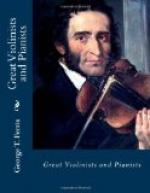The shock had been too great, and Paganini never quitted his bed afterward. The day before his death he seemed a little better, and directed his servant to buy a pigeon for him, as he had a slight return of appetite. On the last evening of his life he seemed very tranquil, and ordered the curtains to be drawn that he might look out of the window at the beautiful night. The full moon was sailing through the skies, flooding everything with splendor. Paganini gazed eagerly, gave a long sigh of pleasure, and fell back on his pillow dead.
VII.
Paganini was the first to develop the full resources of the violin as a solo instrument. He departed entirely from the traditions of violin-playing as practiced by earlier masters, as he believed that great fame could never be acquired in pursuing their methods. A work of Locatelli, one of the cleverest pupils of Corelli, and a great master of technique, first seems to have inspired him with a conception of the more brilliant possibilities of the violin. What further favored Paganini’s new departure was that he lived in an age when the artistic mind, as well as thought in other directions, felt the desire of innovation. The French Revolution stirred Europe to its deepest roots, intellectually as well as politically. At a very early date in his career Paganini seems to have begun experimenting with the new effects for which he became famous, though these did not reach their full fruitage until just before he left Italy on his first general tour. Fetis says: “In adopting the ideas of his predecessors, in resuscitating forgotten effects, in superadding what his genius and perseverance gave birth to, he arrived at that distinctive character of performance which contributed to his ultimate greatness. The diversity of sounds, the different methods of tuning his instrument, the frequent employment of harmonics, single and double, the simultaneous pizzicato and bow passages, the various staccato effects, the use of double and even triple notes, a prodigious facility in executing wide intervals with unerring precision, together with an extraordinary knowledge of all styles of bowing—such were the principal features of Paganini’s talent, rendered all the more perfect by his great execution, exquisitely nervous sensibility, and his deep musical feeling.” In a word, Paganini possessed the most remarkable creative power in the technical treatment of an instrument ever given to a player. Franz Liszt as a pianist approaches him more nearly in this respect than any other virtuoso, but the field open to the violinist was far greater and wider than that offered to the great Hungarian pianist. It was not, however, mere perfection of technical power that threw Europe into such paroxysms of admiration; it was the irresistible power of a genius which has never been matched, and which almost justified the vulgar conclusion that none but one possessed with a demon could do such things.




